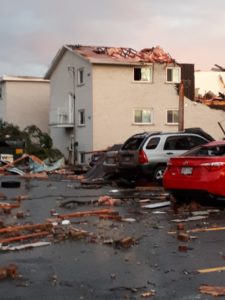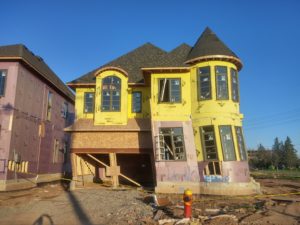The winds of claims: 2018 a bad year for wind losses
0 December 19, 2018 at 12:00 pm by Glenn McGillivray
Gatineau, QC. (G. Martin)
In some years, it’s water. In others, it’s wildfire or hail. This year, it was extreme wind that stood out as a major driver of insured catastrophic loss in Canada.
Indeed, just two events – the May 4 Southern Ontario/Quebec windstorm and the September 21 tornado sequence in the National Capital Region caused well over $800 million in insured losses, based on public numbers compiled by Catastrophe Indices and Quantification Inc. (CatIQ has since updated the totals. If you do not have a subscription, contact the company for details). When claims adjustment expenses are added, the pair of events left the industry with close to $1 billion worth of cheques to write.
Wind also figured into several other smaller cats in Canada this year, though in these cases the peril was combined with rain and hail in some instances, and with winter storm in others.
The May 4 windstorm event proved to be an interesting one for the industry, as insured damage resulted from a large number (considerably more than the Fort McMurray wildfire) of mostly small claims. Damage from the storm was widespread, tracking across all of Southern Ontario from Windsor in the southwest, north of Ottawa and east to the Quebec boundary where its impact was felt along the St. Lawrence Valley past Montreal. The storm track largely matched the area in Southern Ontario and Quebec that is most prone to tornadoes.
Though the system did spawn several weak twisters on the U.S. side, this storm was solely a flat line event for Canada, with peak wind gusts measured at 126 km/h at Hamilton Airport and 119 km/h at Pearson International.
Damage from the storm was largely contained to branches or trees falling on structures and vehicles and loss of shingles and siding. Some instances of sewer backup were reported in both provinces, likely due to failed sump pumps due to loss of power (a key reason ICLR seeks to make emergency backup power for sump systems mandatory). It is assumed that there was considerably more damage experienced from the storm than what was captured by CatIQ, however many property owners either chose not to call their insurance providers or found that damage didn’t exceed deductibles.

Failed house in Oakville, ON (G. McGillivray)
In at least two instances, partially constructed houses collapsed due to the high winds, with cases reported in Georgetown and Oakville, Ontario. Houses that are not yet completed are particularly vulnerable to wind, especially if windows, doors and drywall have yet to be installed, as these features add stiffness or rigidity to the structure. Prior to this event, ICLR observed what appeared to be a growing trend of more partially constructed homes failing in windstorms in Canada. The Institute has commissioned researchers at Western Engineering to investigate the issue and report back with findings and recommendations.
Generally speaking, mitigating the type of wind damage experienced on May 4 is challenging, though some benefits would likely be gleaned from the improved maintenance of trees, both on the private and public sides of property lines (this need has been underscored after several ice storms in Southern Ontario and other places in Canada in recent years). Tree branches need to be pruned regularly, with particular emphasis on removing limbs that hang over or are too close to structures, parking areas and power lines. Dead trees need to be removed entirely.
The tornadoes in the Ottawa/Gatineau area in September proved to be a surprise, as tornadoes tend to be. But two things stand out from the September outbreak.
First is the sheer number of tornadoes experienced in a single day that late in September (such a sequence has never before been experienced in Canada in September or later).
Second is that one of the tornadoes that struck was an EF3. The last F3 to strike in Canada in the month of September was in Merritton, Ontario – now know as St. Catharines – in 1898.
Damage in such places as Dunrobin, Ontario and Gatineau, Quebec was extensive. Many structures in Dunrobin lost roofs, making them write-offs (aerial photos of the area were reminiscent of what one would expect to see out of Oklahoma or Kansas after a tornado). The commercial area of town was also hard hit, with the popular local plaza experiencing severe damage, requiring it to be razed. In Gatineau, much damage was done to low rise rental apartments. Many renters who experienced damage were not insured.
As with previous extreme wind events (Elie, MB 2007, Vaughan, ON 2009, Goderich, ON 2011, Angus, ON 2014, Alonso, MB 2018), Western Engineering’s Storm Damage Assessment Team (with support from ICLR), conducted forensic investigations of stricken areas. This included damage surveys in Dunrobin, Gatineau and Nepean.
On October 12, ICLR hosted a webinar where team members presented their findings. Slides from that event can be found here.
A replay of the session is also available on ICLR’s YouTube Channel.
In addition to supporting Western Engineering in gathering critical information from damage surveys and in lab work related to how homes are built, how and why they fail in extreme wind and how they can be constructed better; ICLR will continue to work with homebuilders and the building code community to incorporate improved wind reduction measures into national and provincial construction codes.
In one key milestone reached this year, ICLR was contracted by the Standards Council of Canada to develop a national wind resilience for Part 9 residential buildings seed document. The seed document will serve as the basis for a National Standard of Canada.
The year showed that extreme wind can be a driver of significant insured loss in Canada (it is likely the second highest cause of catastrophe claims, with water being number one) and that an event doesn’t need to be tornadic to produce big claims numbers.
Losses will likely increase in the years ahead, as communities grow and our built environment becomes a bigger target.
Note: By submitting your comments you acknowledge that insBlogs has the right to reproduce, broadcast and publicize those comments or any part thereof in any manner whatsoever. Please note that due to the volume of e-mails we receive, not all comments will be published and those that are published will not be edited. However, all will be carefully read, considered and appreciated.

Leave a Reply